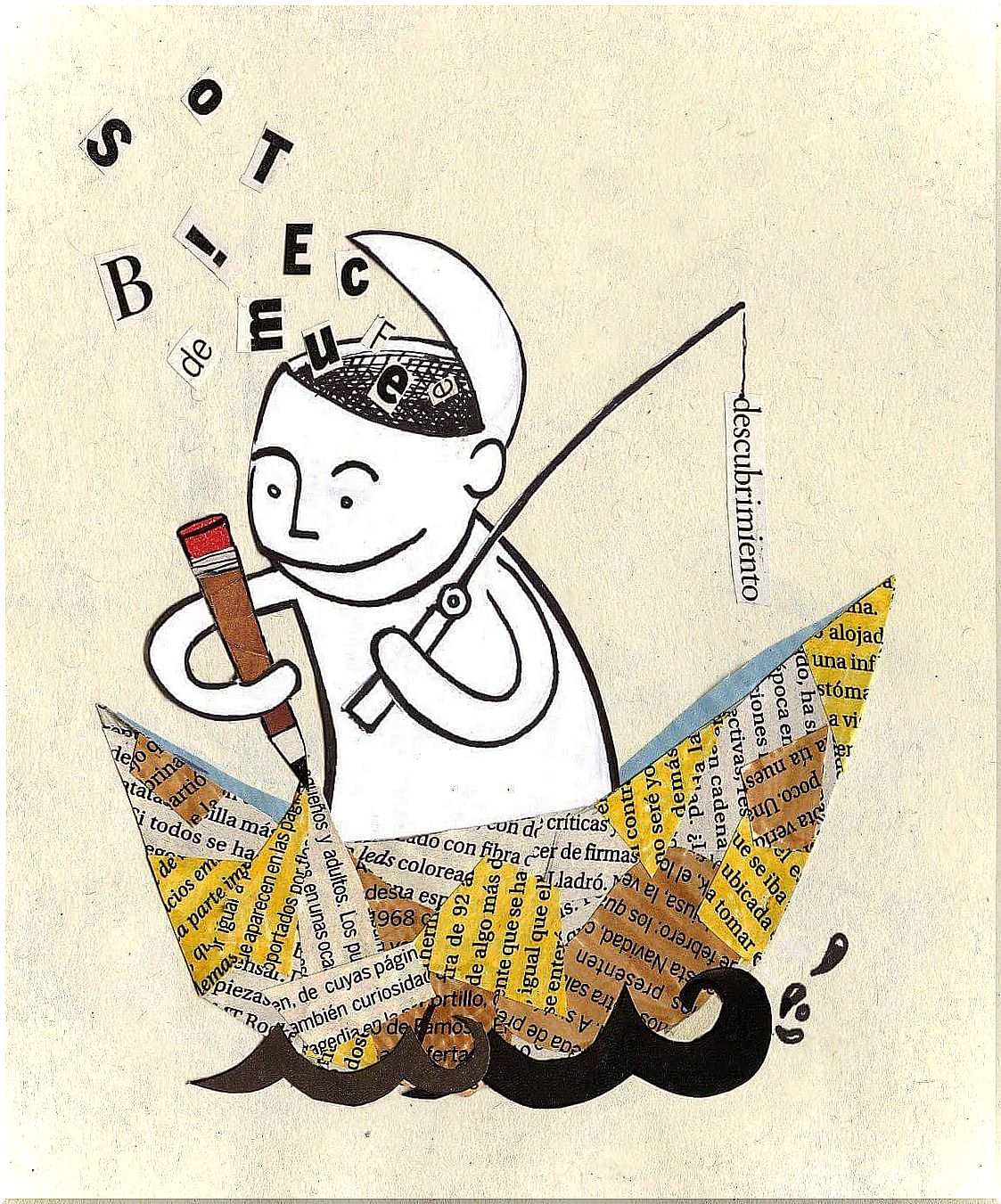Do You Know What Narrative Therapy Is?

Narrative therapy uses the narrative method with therapeutic goals. The narrative method is one that uses a point of view and a narrative voice to present a literary or theatrical story, among others. This narrative method will establish itself as a respectful and non-blaming approach, so that in this method the following maxim is respected: people are experts in their own lives (Morgan, 2004).
As we said, narrative therapy seeks a respectful, nonblaming (nonblaming) approach to therapy and community work. Furthermore, it sees the problem as a separate entity from people and assumes that people have many skills, competencies, convictions, values, commitments and capabilities that will help to reduce the problem’s negative influence on their lives.
For narrative therapy, the word story or narrative means: events linked in sequence, through time and according to a theme. As humans, we interpret, give meaning to the experiences of daily life. We look for a way to explain the events and give them meaning.
This meaning is what gives shape to the story (narrative). We all have many stories about our lives and relationships that occur simultaneously. We have, for example, stories about ourselves, about our abilities, difficulties, competences, actions, desires, work, successes and failures. The way in which we write them and try to give coherence to these stories greatly influences the way in which we continue to live and write them.
We talk about a succession of events held together by a temporal thread. It is exactly from this thread that we select, because the events fit best with the idea of the dominant story. Events that fall outside the dominant story remain hidden or less meaningful (or with a modified meaning) in light of the dominant theme.
For example, if I have a dominant story in which I am a good conductor, every time I respect the signs I check for meaning and that fact and reinforce the conclusions of my story. On the day I am fined, as this event is not in keeping with the dominant story, it is hidden or minimized because it does not fit the overall meaning.
What are the main goals of narrative therapy?
Well then, narrative therapy has as its main objective to offer the person the space to define his own life according to an adaptive narrative way (which is positive for him). The secondary goals would be as follows:
- Incorporate new elements into people’s narratives.
- Achieve making the person able to build a project for a better future.
- Being able to share these new meanings with the environment around us, thus facilitating a new relational dimension.

we are storytellers
It may sound curious to you, but all human beings are storytellers. Tales we tell people, but also tales we tell ourselves. Furthermore, in these tales there is often a part of truth as well as an imagined part.
We are born with a narrative impulse. So we socialize, we create the development of the self, and we establish an autobiographical memory that gives us meaning. The personal narrative is what we explain (to people and to ourselves) about our own life. We create our world ourselves and, therefore, we are responsible for the reading we make of it.
This offers us the opportunity to delineate the first difference between the problem and the person. This difference gives rise to a great opportunity for people to value their own resources and analyze the problem from another perspective. The person’s history will present itself through events linked with the corresponding interpretation that we make of them. From this will establish a narrative voice and a thread of reasoning in which to interfere.
Likewise, in the narrative itself, what we consider and what we discard in our story is decided. Thus, our personal history will be influenced both by sociocultural factors, as well as more individual ones, such as our genetics.
Language is more important than you think
Language is the medium we use to create (or recreate) ourselves and present ourselves. It is also helpful for us to deal with our inner world of thoughts and feelings. Hence the importance of analyzing this language. If we create our reality based on the explanations we give about it, this narrative will define what is called “dominant history effects”.
These effects are derived, for example, from the tone or voice that our more global or general story has. So, if our story is one of abandonment and loss (written and told by us), the effect of this dominant story will be melancholy.
The therapeutic process of narrative therapy
The position of the therapist in this model will change from a specialist to a companion of the person asking for help, who is the co-author of the therapeutic process, and not the client or patient (White, 2004).
The idea of the therapeutic process using narrative techniques is basically to be able to find an alternative story, a deconstruction of the dominant narrative story, in favor of a renewed and different story.
The reflection is in favor of this new narrative seeking what we call isolated achievements, which are those that give us the opportunity to introduce new information and/or approach. Therefore, they give us the opportunity to build a new story and/or identity.

This technique is both very simple and extremely complicated. It is simple in the sense that it represents a linguistic separation from the problem of the patient’s personal identity. What is complicated and difficult is the delicate way in which it is carried out. It is precisely through the careful use of language in the therapeutic conversation that a person’s healing begins and is finally achieved.
The novelty of the narrative approach is that it offers a useful sequence of questions that consistently produce a liberating effect for people. Following this therapeutic sequence is like building an arch with bricks. If you try to take the last step without having patiently placed the first bricks first, your bow will not hold.
Technical description of narrative therapy
We take it for granted that our life is as it is. But we can always rephrase it in another way. In reality, each person can rewrite their story as they wish (García-Martínez, 2012). There are three dimensions around the narrative matrix that enable a coherent, complex and multiple narrative (Gonçalves, 2002):
- Narrative structure: construction of a meaning of the experiences themselves through the connection process through the different narrative episodes of our life. The structure consists of:
- A beginning, which is the point where we start our story. We can go back to the example of a customer who goes to a consultation for the first time and demonstrates not knowing where to start. One of the therapist’s responses could be “from the beginning” or “wherever it’s easier to start explaining your story” (this will be the beginning).
- A development of history. It includes concrete events, internal responses, protagonists’ objectives, changing actions, cause and effect, and finally the context.
- An ending, which is considered when obtaining certain results and/or closing the narrative.
- Narrative process: it has to do with the way we explain our lives, that is, what touch we give to it (for example, of dramatic commitment).
- Narrative content: refers to the diversity and multiplicity of narrative production, the themes or plots we tell, sometimes falling into the “scratched record” or thinking about old themes without resolving.

Narrative Technique Exercises
First steps to change our internal dialogue:
The internal dialogue is interrupted just as it was started, by an act of will. You are as I say you are. But it could change if you start talking to yourself in a different way (Castaneda, 1994), if you start telling yourself that you are different. Below, I present a series of exercises to work with inner dialogue, that voice that continually speaks to us and translates reality:
- Know your internal dialogue: Pay attention to the form and content of your internal dialogue. Think about whether it’s destructive or constructive dialogue, restless or quiet. And definitely, whether it’s negative or positive. To change it, first it is necessary to know its content, the most frequent thoughts to which we dedicate ourselves.
- Ask the right questions: Analyze the situation that presents itself by changing the questions you can ask yourself. For example, instead of asking “why did this happen to me?”, we can ask “what can I learn from this situation?”.
- Change the approach: it is possible to change the way we speak. Talking to us like a mother talks to a child can help us. Incorporate loving and kind words into your self-talk.
Personal Narrative Tools
There are several resources to explore aspects of our narrative, such as metaphors, short stories or therapeutic letters, among others. Let’s look at some of these features.
Resources for getting to know yourself
- Life stories : these are reports intended to give meaning or justify a certain view of events.
- Short summary about yourself: It’s about imagining and writing a letter to a person you haven’t met in a while.
- Ten years later: describe how you see yourself in ten years’ time physically, internally, professionally, in your relationships with people and in your personal tastes.
- Preferences: thinking and writing down what our preferences are, to reassure ourselves and give ourselves the pleasure of expressing freedom with our own choices.
- Spaces: separate the different spaces to dedicate to the important people in your life, the most significant places, the happiest events, the most pleasurable sensations, the most beautiful dreams and the loves that made you mature and grow.
- I remember…: invite the person to finish this sentence without thinking too much about the answer. You can use several of these incomplete sentences to explore and work.
- Loving the mystery: it is a question of searching within ourselves for those questions that do not have an answer.

Metaphors and tales
A metaphor is a linguistic form that makes an implicit comparison between two different entities, a dramatic feature that draws attention and offers a new framework through which the client can consider a new experience (Lankton and Lankton, 1983).
There are three types of metaphor to be used in the therapeutic process:
- Those that refer to the therapist’s personal experiences.
- Those that make reference to obvious truths.
- Stories tailored to the person’s circumstances.
Therapeutic metaphors can be used to formulate an opinion, suggest solutions, access and use of resources, personal knowledge, seed specific ideas, etc.
On the other hand, tales are expressions of essential philosophical truths, explanations of nature or dream reports. The short stories are therapeutic because the person has the possibility of finding his own solution by rewriting his story and the conflicts that appear in it.
The tale does not refer to the outside world, even if it is realistic enough and has everyday features woven into it. The unreal nature of these tales is an important resource, as it makes clear that the interest of the tales is not useful information about the external world, but the internal processes that take place in the individual (Gordon, 1978).
In short, by telling our personal stories to strangers, we get rid of them and make them the past. This allows us to start projecting the future we want, documenting these tales so they don’t get lost in the way and can serve as inspiration to others. The ultimate goal is for people to understand the power that the way they tell their stories has, to tell them and to see how the way they do it influences the way they behave in the present.
Bibliography:
White, M. (2002) “ The narrative approach in the experience of therapists ”. Gedisha.
Nomen Martín, L. (2016) “50 psychotherapeutic techniques” . Pyramid.









